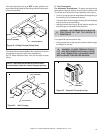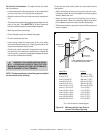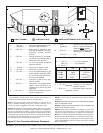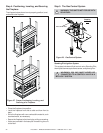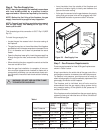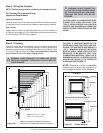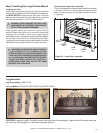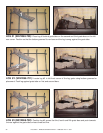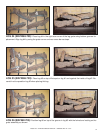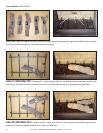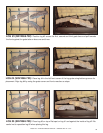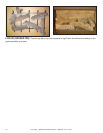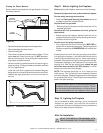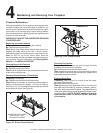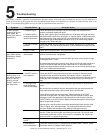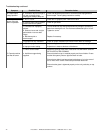
Heat & Glo • PIER/ST/L&RCOR-HVB-CE • 2068-900 Rev. H • 6/07
43
5
Troubleshooting
With proper installation, operation, and maintenance the gas fireplace will provide years of trouble-free service. If you do experience a
problem, this trouble shooting guide will assist a qualified service person in the diagnosis of a problem and the corrective action to be
taken. This troubleshooting guide can only be used by a qualified service technician.
Symptom Possible Cause Corrective Action
1. After repeated
triggering of the red
piezo button, the
spark ignitor will not
light the pilot.
a. Defective ignitor. Check the spark at the electrode and pilot. If no spark and electrode wire is
properly connected, replace the ignitor.
b. Defective pilot or
misaligned electrode
(spark at electrode).
Using match, light the pilot. If the pilot lights, turn off the pilot and trigger the red or
black piezo button again. If the pilot lights, an improper gas/air mixture caused the
bad lighting and a longer purge period is recommended. If the pilot will not light,
ensure the the gap at the electrode and pilot is 0.3 cm to have a strong spark. If
the gap is OK, replace the pilot.
c. No gas or low gas
pressure.
Check the remote shut-off valves from the fireplace. Usually, there is a valve near
the gas main. There can be more than one (1) valve between the fireplace and the
main.
d. No LP in tank. Check the LP (propane) tank. You may be out of fuel.
2. The pilot will not
stay lit after carefully
following the lighting
instructions.
a. Defective
thermocouple.
Check that the pilot flame impinges on the thermocouple. Clean and/or adjust the
pilot for maximum flame impingement.
Ensure that the thermocouple connection at the gas valve is fully inserted an tight
(hand tighten plus 1/4 turn).
Disconnect the thermocouple from the valve, place one millivolt meter lead wire on
the tip of the thermcouple and the other meter lead wire on the thermocouple
copper lead. Start the pilot and hold the valve knob in. If the millivolt reading is less
than 15mV, replace the thermocouple.
b. Defective valve. If the thermocouple is producing more than 15 millivolts, replace faulty valve.
3. The pilot is
burning, there is no
gas burner, the valve
knob is in the ON
position, and the
ON/OFF switch is in
the ON position.
a. ON/OFF switch or
wires defective.
Check the ON/OFF switch and wires for proper connections. Place the jumper
wires across the terminals at the switch. If the burner comes on, replace the
defective switch. If the switch is OK, place the jumper wires across the switch wires
at the gas valve. If the burner comes on, the wires are faulty or connections are
bad.
b. Thermopile may
not be generating
sufficient millivoltage.
If the pilot flame is not close enough physically to the thermopile, adjust the pilot
flame.
Be sure the wire connections from the thermopile at the gas valve terminals are
tight and that the thermopile is fully inserted into the pilot bracket.
Check the thermopile with a millvolt meter. Take the reading at TH-TP&TP
terminals of the gas vlave. The meter should read 325 millivolts minimum, while
holding the valve knob depressed in the pilot position, with the pilot lit, and the
ON/OFF switch in the OFF position. Replace the faulty thermopile if the reading is
below the specified minimum.
With the pilot in the ON position, disconnect the thermopile leads from the valve.
Take a reading at the thermopile leads. The reading should be 325 millivolts
minimum. Replace the thermopile if the reading is below the minimum.
c. Defective valve. Turn the valve knob to the ON position. Place the ON/OFF switch in the ON
position. Check the millivolt meter a the thermopile terminals. The millivolt meter
should read greater than 125mV. If the reading is acceptable, and if the burner
does not come on, replace the gas valve.
d. Plugged burner
orifice.
Check the burner orifice for stoppage. Remove stoppage.
e. Wall switch or
wires are defective.
Follow the corrective action in Symptom and Possible Cause 1.a above. Check
the switch and wiring. Replace where defective.



